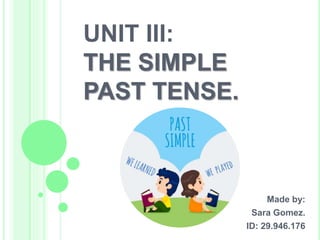Unit III english
•Download as PPTX, PDF•
0 likes•14 views
Unit III simple past tense
Report
Share
Report
Share

Recommended
More Related Content
What's hot
What's hot (20)
Similar to Unit III english
Similar to Unit III english (20)
Recently uploaded
https://app.box.com/s/7hlvjxjalkrik7fb082xx3jk7xd7liz3TỔNG ÔN TẬP THI VÀO LỚP 10 MÔN TIẾNG ANH NĂM HỌC 2023 - 2024 CÓ ĐÁP ÁN (NGỮ Â...

TỔNG ÔN TẬP THI VÀO LỚP 10 MÔN TIẾNG ANH NĂM HỌC 2023 - 2024 CÓ ĐÁP ÁN (NGỮ Â...Nguyen Thanh Tu Collection
https://app.box.com/s/x7vf0j7xaxl2hlczxm3ny497y4yto33i80 ĐỀ THI THỬ TUYỂN SINH TIẾNG ANH VÀO 10 SỞ GD – ĐT THÀNH PHỐ HỒ CHÍ MINH NĂ...

80 ĐỀ THI THỬ TUYỂN SINH TIẾNG ANH VÀO 10 SỞ GD – ĐT THÀNH PHỐ HỒ CHÍ MINH NĂ...Nguyen Thanh Tu Collection
Recently uploaded (20)
Kodo Millet PPT made by Ghanshyam bairwa college of Agriculture kumher bhara...

Kodo Millet PPT made by Ghanshyam bairwa college of Agriculture kumher bhara...
Food safety_Challenges food safety laboratories_.pdf

Food safety_Challenges food safety laboratories_.pdf
Salient Features of India constitution especially power and functions

Salient Features of India constitution especially power and functions
Sensory_Experience_and_Emotional_Resonance_in_Gabriel_Okaras_The_Piano_and_Th...

Sensory_Experience_and_Emotional_Resonance_in_Gabriel_Okaras_The_Piano_and_Th...
TỔNG ÔN TẬP THI VÀO LỚP 10 MÔN TIẾNG ANH NĂM HỌC 2023 - 2024 CÓ ĐÁP ÁN (NGỮ Â...

TỔNG ÔN TẬP THI VÀO LỚP 10 MÔN TIẾNG ANH NĂM HỌC 2023 - 2024 CÓ ĐÁP ÁN (NGỮ Â...
Interdisciplinary_Insights_Data_Collection_Methods.pptx

Interdisciplinary_Insights_Data_Collection_Methods.pptx
Beyond_Borders_Understanding_Anime_and_Manga_Fandom_A_Comprehensive_Audience_...

Beyond_Borders_Understanding_Anime_and_Manga_Fandom_A_Comprehensive_Audience_...
Basic Civil Engineering first year Notes- Chapter 4 Building.pptx

Basic Civil Engineering first year Notes- Chapter 4 Building.pptx
General Principles of Intellectual Property: Concepts of Intellectual Proper...

General Principles of Intellectual Property: Concepts of Intellectual Proper...
ICT role in 21st century education and it's challenges.

ICT role in 21st century education and it's challenges.
80 ĐỀ THI THỬ TUYỂN SINH TIẾNG ANH VÀO 10 SỞ GD – ĐT THÀNH PHỐ HỒ CHÍ MINH NĂ...

80 ĐỀ THI THỬ TUYỂN SINH TIẾNG ANH VÀO 10 SỞ GD – ĐT THÀNH PHỐ HỒ CHÍ MINH NĂ...
This PowerPoint helps students to consider the concept of infinity.

This PowerPoint helps students to consider the concept of infinity.
Unit III english
- 1. UNIT III: THE SIMPLE PAST TENSE. Made by: Sara Gomez. ID: 29.946.176
- 2. WHAT IS THE SIMPLE PAST TENSE? Well, that’s an easy question to answer!! The simple past is a verb tense that is used to talk about things that happened or existed before now. YOU NEED TO KNOW THAT: Unlike the past continuous tense, which is used to talk about past events that happened over a period of time, the simple past tense emphasizes that the action is finished.
- 3. GRAMMATICAL RULES -FORM: First, we need to know that in english, there are REGULAR VERBS and irregular verbs. For regular verbs: • Add -ed to the root form of the verb (or just -d if the root form already ends in an e). For example: Play - Played. Type - Typed. In verbs that end with a “y”, change the “y” for an “i”. study → studied. If the verb ends in a short vowel and a consonant, add the last consonant twice. Stop → stopped
- 4. You can also use the simple past to talk about a PAST STATE OF BEING!, such as the way someone felt about something. This is called PAST CONTINUOUS. This is often expressed with the simple past tense of the verb to be and an adjective, noun, or prepositional phrase. For example: They were studying last night.
- 5. FOR IRREGULAR VERBS. Things get more complicated here. Irregular verbs are those that DON’T end in “ed”. Sadly, you will have to learn these cases in order to use the simple past tense in the correct way. The simple past tense of some irregular verbs looks exactly like the root form: Put→Put Cut→Cut Cost→Cost For other irregular verbs, including the verb to be, the simple past forms are more erratic: See→Saw Build→Built Go→Went Do→Did
- 6. NOW LET’S SEE SOME EXAMPLES Regular form: She danced all night long. He played the violin. I studied Frenh when I was a child. Irregular form: I thought it was a great idea! She left her phone at church (That has happened to me a couple of times) .
- 7. FOR NEGATIVE SENTENCES In this case, things are easy! We just need to use the word “DIDN’T” (which is short for “did not”). In this case, we do not care who we’re refering to. See some examples: I didn’t go to work today. I’m sick. Instead of taking the verb “go” and change it according to its simple past form (went), we just used the word “didn’t”, and that way, we changed the sentence into a negative sentence.
- 8. IF WE WANT TO MAKE QUESTIONS… We just follow these simple steps: Auxiliar verb (to do) + subjet + principal verb (present form) See some examples: Did you buy a car last week? +Yes, I bought a ar last week. -No, I didn’t buy a car last week. I’m poor (See? We used the negative sentence form we just learnt)
- 9. NOW I’LL LEAVE YOU A LIST WITH SOME VERBS SO YOU CAN PRATICE A BIT MORE! Common Regular Verbs in the Past Tense
- 10. Common Irregular Verbs in the Past Tense